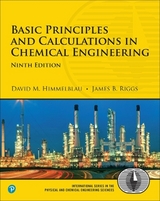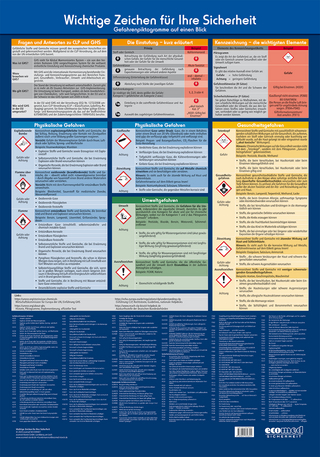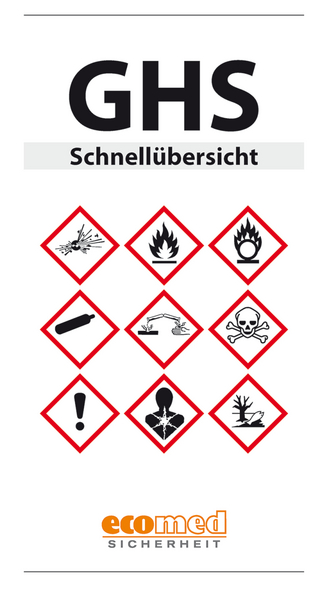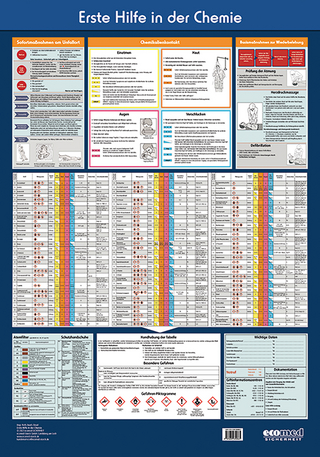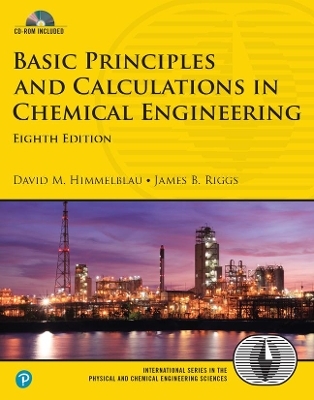
Basic Principles and Calculations in Chemical Engineering
Pearson
978-0-13-234660-3 (ISBN)
- Titel erscheint in neuer Auflage
- Artikel merken
Basic Principles and Calculations in Chemical Engineering, Eighth Edition goes far beyond traditional introductory chemical engineering topics, presenting applications that reflect the full scope of contemporary chemical, petroleum, and environmental engineering. Celebrating its fiftieth Anniversary as the field’s leading practical introduction, it has been extensively updated and reorganized to cover today’s principles and calculations more efficiently, and to present far more coverage of bioengineering, nanoengineering, and green engineering.
Offering a strong foundation of skills and knowledge for successful study and practice, it guides students through formulating and solving material and energy balance problems, as well as describing gases, liquids, and vapors. Throughout, the authors introduce efficient, consistent, student-friendly methods for solving problems, analyzing data, and gaining a conceptual, application-based understanding of modern chemical engineering processes. This edition’s improvements include many new problems, examples, and homework assignments.
Coverage includes
Modular chapters designed to support introductory chemical engineering courses of any length
Thorough introductions to unit conversions, basis selection, and process measurements
Consistent, sound strategies for solving material and energy balance problems
Clear introductions to key concepts ranging from stoichiometry to enthalpy
Behavior of gases, liquids, and solids: ideal/real gases, single component two-phase systems, gas-liquid systems, and more
Self-assessment questions to help readers identify areas they don’t fully understand
Thought/discussion and homework problems in every chapter
New biotech and bioengineering problems throughout
New examples and homework on nanotechnology, environmental engineering, and green engineering
Extensive tables, charts, and glossaries in each chapte
Many new student projects
Reference appendices presenting atomic weights and numbers, Pitzer Z factors, heats of formation and combustion, and more
Practical, readable, and exceptionally easy to use, Basic Principles and Calculations in Chemical Engineering, Eighth Edition,is the definitive chemical engineering introduction for students, license candidates, practicing engineers, and scientists.
CD-ROM INCLUDES
The latest Polymath trial software for solving linear, nonlinear, and differential equations and regression problems
Point-and-click physical property database containing 700+ compounds
Supplemental Problems Workbook containing 100+ solved problems
Descriptions and animations of modern process equipment
Chapters on degrees of freedom, process simulation, and unsteady-state material balances
Expert advice for beginners on problem-solving in chemical engineering
David M. Himmelblau was (until his death in April) the American Petrofina Foundation Centennial Professor in Chemical Engineering at the University of Texas, Austin. The author of sixteen books, his areas of research included the use of artificial neural networks for fault diagnosis and data rectification. James B. Riggs is Professor in the Chemical Engineering Department at Texas Tech University, where he directs the Texas Tech Process Control and Optimization Consortium. His books include Chemical Process Control, Second Edition and An Introduction to Numerical Methods for Chemical Engineers, Second Edition.
Preface xiii Read Me xv
Acknowledgements xix
About the Authors xx
PART I: INTRODUCTION 1
Chapter 1: What are Chemical Engineering and Bioengineering? 3
1.1 Introduction 3
1.2 A Brief History of Chemical Engineering 4
1.3 Where Do Chemical and Bioengineers Work? 6
1.4 Future Contributions of Chemical and Bioengineering 7
1.5 Conclusion 10
Chapter 2: Introductory Concepts 11
2.1 Systems of Units 12
2.2 Conversion of Units 17
2.3 Dimensional Consistency 25
2.4 Significant Figures 29
2.5 Validation of Results 36
2.6 The Mole and Molecular Weight 37
2.7 Choosing a Basis 44
2.8 Density and Specific Gravity 49
2.9 Concentration 55
2.10 Temperature 59
2.11 Pressure and Hydrostatic Head 65
2.12 Flow Rate 78
Part II: Material Balances 99
Chapter 3: Material Balances 101
3.1 Introduction to Material Balances 102
3.2 A General Strategy for Solving Material Balance Problems 123
Chapter 4: Material Balances without Reaction 159
Chapter 5: Material Balances Involving Reactions 189
5.1 Stoichiometry 190
5.2 Terminology for Reaction Systems 198
5.3 Species Mole Balances 210
5.4 Element Material Balances 226
5.5 Material Balances for Combustion Systems 233
Chapter 6: Material Balances for Multi-Unit Systems 267
6.1 Primary Concepts 268
6.2 Sequential Multi-Unit Systems 271
6.3 Recycle Systems 290
6.4 Bypass and Purge 306
6.5 The Industrial Application of Material Balances 314
Part III: Gases, Vapors, and Liquids 347
Chapter 7: Ideal and Real Gases 349
7.1 Ideal Gases 350
7.2 Real Gases: Equations of State 366
7.3 Real Gases: Compressibility Charts 377
7.4 Real Gas Mixtures 384
Chapter 8: Multiphase Equilibrium 411
8.1 Introduction 411
8.2 Phase Diagrams and the Phase Rule 413
8.3 Single Component Two-Phase Systems (Vapor Pressure) 425
8.4 Two-Component Gas/Single-Component Liquid Systems 436
8.5 Two Component Gas/Two Component Liquid Systems 455
8.6 Multicomponent Vapor-Liquid Equilibrium 466
Part IV: Energy 487
Chapter 9: Energy Balances 489
9.1 Terminology Associated with Energy Balances 491
9.2 Types of Energy to Be Included in Energy Balances 496
9.3 Energy Balances without Reaction 530
Chapter 10: Energy Balances: How to Account for Chemical Reaction 597
10.1 The Standard Heat (Enthalpy) of Formation 598
10.2 The Heat (Enthalpy) of Reaction 603
10.3 Integration of Heat of Formation and Sensible Heat 614
10.4 The Heat (Enthalpy) of Combustion 635
CHAPTER 11: Humidity (Psychrometric) Charts and Their Use 653
11.1 Terminology 654
11.2 The Humidity (Psychrometric) Chart 657
11.3 Applications of the Humidity Chart 666
Part V: Supplementary Material 681
Chapter 12: Analysis Of The Degrees Of Freedom in a Steady-State Process 683
Chapter 13: Heats of Solution and Mixing 708
Chapter 14: The Mechanical Energy Balance 728
Chapter 15: Liquids and Gases in Equilibrium with Solids 756
Chapter 16: Solving Material and Energy Balances UsingProcess Simulators (Flowsheeting Codes) 768
Chapter 17: Unsteady-State Material And Energy Balances 800
Appendixes 827
Appendix A: Answers to Supplemental Questions and Problems 829
Appendix B: Atomic Weights and Numbers 844
Appendix C: Table of the Pitzer Z0 and Z1 Factors 845
Appendix D: Heats of Formation and Combustion 850
Appendix E: Answers to Selected Problems 854
Appendix F: Physical Properties Of Various Organic And Inorganic Substances 861
Appendix G: Heat Capacity Equations 873
Appendix H: Vapor Pressures 877
Appendix I: Heats of Solution and Dilution 878
Appendix J: Enthalpy-Concentration Data 879
Appendix K: Thermodynamic Charts 886
Appendix L: Physical Properties of Petroleum Fractions 893
Appendix M: Solution of Sets of Equations 902
Appendix N: Fitting Functions to Data 924
Index 928
| Erscheint lt. Verlag | 18.10.2012 |
|---|---|
| Reihe/Serie | International Series in the Physical and Chemical Engineering Sciences |
| Sprache | englisch |
| Maße | 206 x 258 mm |
| Gewicht | 1840 g |
| Themenwelt | Mathematik / Informatik ► Mathematik |
| Naturwissenschaften ► Chemie ► Technische Chemie | |
| Technik ► Maschinenbau | |
| Technik ► Umwelttechnik / Biotechnologie | |
| ISBN-10 | 0-13-234660-5 / 0132346605 |
| ISBN-13 | 978-0-13-234660-3 / 9780132346603 |
| Zustand | Neuware |
| Informationen gemäß Produktsicherheitsverordnung (GPSR) | |
| Haben Sie eine Frage zum Produkt? |
aus dem Bereich
